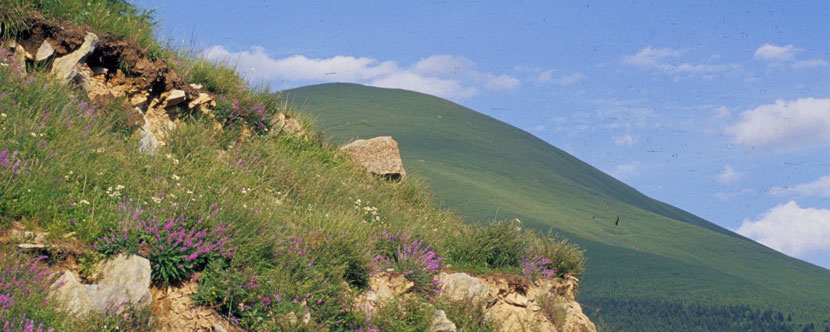Monk Ennin’s 9th c. Journey
Japanese Monk Ennin crossed the ocean from Japan to Tang China as a member of the ambassadorial mission of 838. He kept a diary of his more than nine years traveling around the country learning Buddhist doctrine and practices. Ennin’s Diary, The Record of a Pilgrimage to Tang China in Search of the Law, is one of the world’s great travelogues and is invaluable for learning not only about the impressive bureaucracy, transportation and communications of Tang, but also about the situation of the common people and of Buddhist persecutions. For almost thirty years I have been researching and following Ennin’s path and photographing what I saw of today’s China where he had journeyed. Through Ennin’s experiences we learn what the important Japan and China cultural exchanges were really like, as well as the crucial role in the sea trade and shipbuilding played by the Korean (Silla) peoples living in port cities in China. In Japan, Ennin’s personage is still widely respected although his Diary has yet to receive the high recognition it is due. Thus through publications, photo exhibitions, lectures, classes and tours to “Walk with Ennin” I have tried to stimulate interest in Ennin’s important work. Since 2001, my friends and I have been planting trees along his route in China, not just to commemorate this monk’s journey but also as a sign of gratitude to all those people who showed him hospitality during his stay. I call this the “Ennin Green Road”.

Monk Ennin’s Travels in Tang China
It is almost 1,200 years ago that Japanese monk Ennin (794~864) traveled with an ambassadorial delegation on an official visit to Tang dynasty China. Ennin was a senior monk of forty years old when he crossed the seas in search of answers to many questions from China’s great scholar-abbots concerning Buddhist philosophy.
The visit turned into a more than nine-year sojourn from 838 to 847 covering some 7,500 kilometers. His diary of 70,000 Chinese characters compiled in four scrolls, “The Record of a Pilgrimage to China”, is a unique first hand glance into Tang politics, economics, culture, Buddhism and, especially, the lives of the common people.
Ennin faced considerable hardship, but he was strongly determined to bring back knowledge to Japan not only of religious practices, but also what he learned of Buddhist music, dance, ceremonies, sculpture, painting and architecture. After his return, he became the third abbot of Enryakuji Temple on Mt. Hiei outside of Kyoto. He was given the posthumous title of Jikaku Daishi, by which he is famous throughout Japan.
I first read the English translation of Ennin’s diary done by Harvard Professor Edwin O. Reischauer when I was a student. I was deeply moved by Ennin’s account of his encounters as he walked a disciplined pace of 30-40 km a day. The entries concerning his impressions of the life around him and the way he met successive challenges were particularly interesting.
From the early 1980s I began to follow his footsteps wherever I could and to study his diary charting out a very detailed course of his passage using copies of ancient maps. With the help of a number of friends who have accompanied me on various parts of his path, I visited and photographed almost all places mentioned in his account, both the dots where he stayed and the lines between them. Often the places where Ennin walked are now mere paths in almost forgotten valleys or over rugged mountains. As Ennin did, I also crossed the Yellow Sea from Japan, boated along ancient canals, and used the same ferry crossings or old bridges. I also explored sites where communities of immigrants from the Korean peninsula had settled along the coast in Tang times and who were especially supportive of Ennin as translators, ship builders and patrons.
From my research and field work I have tried to spread the word of Ennin’s Diary not only for its historical importance, but as an example of cultural exchange between people’s of East Asia. In addition to my book and numerous articles, I have given speeches and held photo exhibits in China and Japan.
Publications
Following the Tracks of Ennin’s 9th c. Journey, the Diary of a Japanese Monk in Today’s China was published in 2007 (China Intercontinental Press). in English, Japanese and Chinese. Also published in Japan by Random House Kodansha in 2007, (Japanese)
“Explorations to find the Footsteps of the Japanese Xuan Zang: Ennin” China National Geography,pp.124~141, 2003.10, Chinese)
“Following the Footsteps of Monk Ennin”, The Voice of Dharma 法音 (Chinese), 2004.9, 10
“Ennin’s Seven Days of Silence”, Materials on Ennin and a Stone Stele (Kooji Shuin Press) (Japanese), 2011
Interview and columns: On Pilgrimage Walks to Old Temples Related to Jikaku Daishi Ennin, Diamond Publ. (Japanese), 2012
Ennin Jikaku Daishi 838-2012, Virginia Stibbs Anami Historical Pictures and Ye Xue’s Buddhist Paintings, pamphlet for joint exhibition in Beijing, Songzhuang, Xiaopucun , 2012.4~5
also see Ennin Latest
Documentaries
“Monk Ennin; Following the Diary of a Sojourn to Tang China”
and “Diary of Ennin, Monk’s Travels to Tang China”, NHK 2002
Exhibitions
Photo exhibitions on Ennin in China: Beijing (2006), Yangzhou (2006), Baoding (2008), Qingdao (2009), Xi’an (2010), Beijing Songzhuang, Xiaopucun (2012), Yunjusi Temple, Beijing (2012)
In Japan : Tokyo (2007, 2012) and Mibu in Tochigi Prefecture (2009)
Other Activities
Lecture courses on Ennin at “Otona no Kyuujitsu Club” of Zippangu, JR East
Ennin Tours to various parts of China: 2007, 2009, 2010, 2011, 2012
Ennin Mapping, Tang China 840s, WorldMap Digital Mapping, worldmap.harvard.edu/maps/ennin

